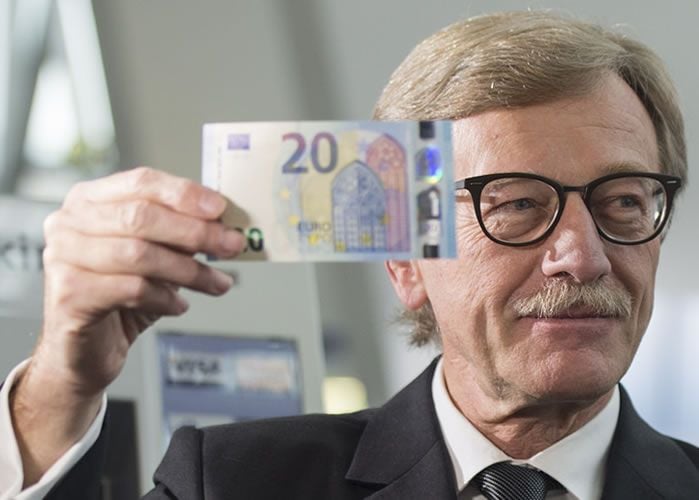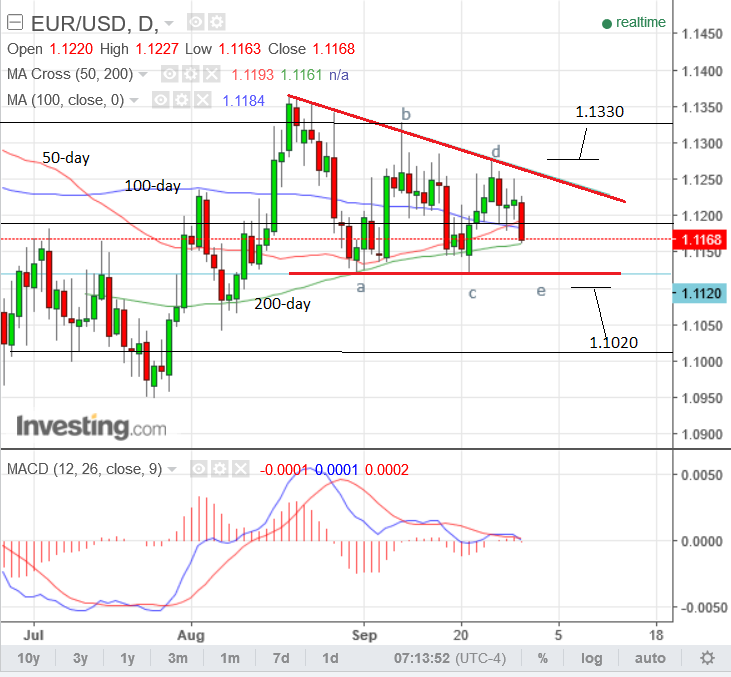Forecasts Confirm Outlook for EUR/USD (EUR/USD) Turning Increasingly Bearish, Dudley Aids USD Strength

The US Dollar is generally on Tuesday 4th October with USD/JPY rallying through 102 and EUR/USD falling back through 1.12.
The implied probability of a Fed hike by year-end has risen to a recent high of 60%, despite cautious comments from NY Fed’s Dudley late on Monday 3rd.
Dudley noted:
"A risk management approach to monetary policy would suggest that the more concerned one is with the effectiveness of these policies at the zero lower bound, the more cautious one would be in the process of removing accommodation."
As long as that probability keeps heading higher, expect the USD to move alongside. Indeed, we regard this as the single most important driver of Euro-Dollar at present.
The technical outlook for the EUR/USD pair suggests a 'less bullish' stance than we have advocated over previous weeks.
The pair has sold off once again into the triple layer of major moving averages in the 1.11s, which include the 50, 100 and 200-day.
It will require a major shock to pierce beneath these – however with Deutsche Bank’s recent woes - that is quite possible.
The flag-like consolidation pattern which formed since the August highs has weakened and now looks more like a triangle, possibly a right-angled triangle:
Right angled triangles tend to break down below the flat edge, which in this case would mean a breakdown.
This could happen after the current component wave finishes since it is an e-wave and therefore probably the last wave.
A break below the lower border and the 1.1100s would confirm a downside breakout and probably a move lower towards a target at support at 1.1020.
Alternatively, a still possible scenario is a break higher out the triangle or consolidation currently forming.
Such a move would be confirmed with a break above the d-wave highs at 1.1279, confirming a move up to a target at 1.1330.
The US Dollar Outlook: The Non-Farm Payrolls Number to Watch, Waning Fed Hike Expectations
The dollar remains subdued due to stewing rate hike sensibilities.
In her most recent comment, Fed President Janet Yellen continued to want to wait before going ahead with a rise, saying inflation was still not high enough and therefore we have “room to run”.
Standing member Powell agreed, as does Deputy Governor Fischer.
Other recent Fed speakers have gone with type, with no real change in stance from any of them on which to peg hopes of a sooner/later hike.
The overwhelming consensus appears to be for a December rise, with a 55% according to current market-based probability, slightly below the 60% previously.
Only when expectations for a rate hike start increasing again would we expect the broader US Dollar complex to start appreciating further.
The Trump factor still has potential to influence the dollar this week, with the consensus now appearing to be that the currency would probably rise following an election, given the fall in imports which would result from his protectionist agenda, as well as other factors.
The rise in interest rates and inflation following a trump win would also probably boost the US dollar.
However, not all analysts agree, with some pointing out that the currency could suffer a lack of confidence with such a disparaged leader at the helm.
Overall the analysis seems to point to more stability for the dollar than the Euro, however, any easing in the DB saga is likely to see a sudden strong recovery in the pair.
Given it is the Euro which has the most potential for volatility, and the fact that analysts unanimously agree DB will not be allowed to fail, there is definitely the potential for a recovery in the pair in the week ahead, as things come to a head.
In addition, the crisis is unlikely to be anywhere as bad as Lehman’s given the increased liquidity in the system due to recent central bank efforts.
Data in the coming week centres on the release of Non-Farm Payrolls on Friday, October 7, which is expected to show a 170k rise.
A rise above expectations is likely to have a very positive impact on the Dollar as it will increase the chances of a Federal Reserve rate hike before the end of the year.
The next most important result is ISM Manufacturing and Non-Manufacturing on Monday and Wednesday respectively.
Outlook for the Euro: Banking Crisis Abates, for Now
Deutsche Bank (DB), Germany’s largest lender, is facing a financial crisis after having been slapped with a 14bn dollar fine by the US Department of Justice (DOJ) for mortgage-backed security violations.
The combination of the high cost of the fine and anaemic profits due to low deposit and lending rates set by the European Central Bank (ECB) which limit how much profit Eurozone banks can make.
“The resulting cash crunch could test the bank's liquidity and send financial markets into panic,” said Kathy Lien, Director of BK Asset Management.
On Thursday it was reported by Bloomberg that major hedge funds and investors were pulling capital out of the DB en masse leading to even greater concerns about its financial stability.
Deutsche is the world’s fourth-largest bank so any failure would have serious ramifications for the world’s financial system.
“It's highly unlikely that officials will allow it to fail given its importance not only to the European economy but to the global economy as well,” added Lien.
Given the severity of the threat it is somewhat strange the euro has not fallen more deeply.
The reason may lie in the fact that investors see DB as the epitome of ‘too big to fail’ and therefore unlikely to actually go bankrupt, despite no forthcoming support from the German government so far.
According to CIBC Economics, the euro has remained resilient during the DB crisis because it lessens the chances of the European Central Bank (ECB) increasing stimulus since this would put even more pressure on bank balance sheets.
It also increases the chances of the ECB embracing a pro-bank strategy such as BOJ’s recent yield-targeting, and possibly changing their long-term strategy to a less stimulus-orientated one – another positive for the euro which weakens from stimulus, as it tends to keep rates low and dilutes individual currency unit strength.
The euro may – counter-intuitively - gain succour from weaker Eurozone banks as they will be less likely to be able to recycle the region’s current account surplus.
If DB fails, the resulting global financial crisis might send supportive flows to the euro, offsetting the immediate damage.
This would be via the repatriation of euro-denominated money lent to purchase riskier emerging market debt due to the region’s low borrowing, and the profitability of the carry trade.
Clearly, there is the potential for a counter-intuitive reaction from the euro to the DB crisis, or a less volatile-than-expected reaction, except possibly in Swiss Franc or Yen pairs, given these are both even stronger safe havens than the euro.
From a pure data perspective, the coming week promises Manufacturing, and Services PMIs on Monday and Wednesday prospectively, the ECB September meeting minutes on Thursday and Retail Sales on Wednesday.











